Our novelty cutlery train will now be departing according to its regular schedule. The conductor will come by to slice your tickets clean in half very shortly.
I admit I was absent last week, but that’s because I was out perambulating upon my velocipede, whereupon I took this daguerreotype. (Knives carried on said expedition: My Leatherman Wave, Böker Rold, and HUAAO Bugout clone.)
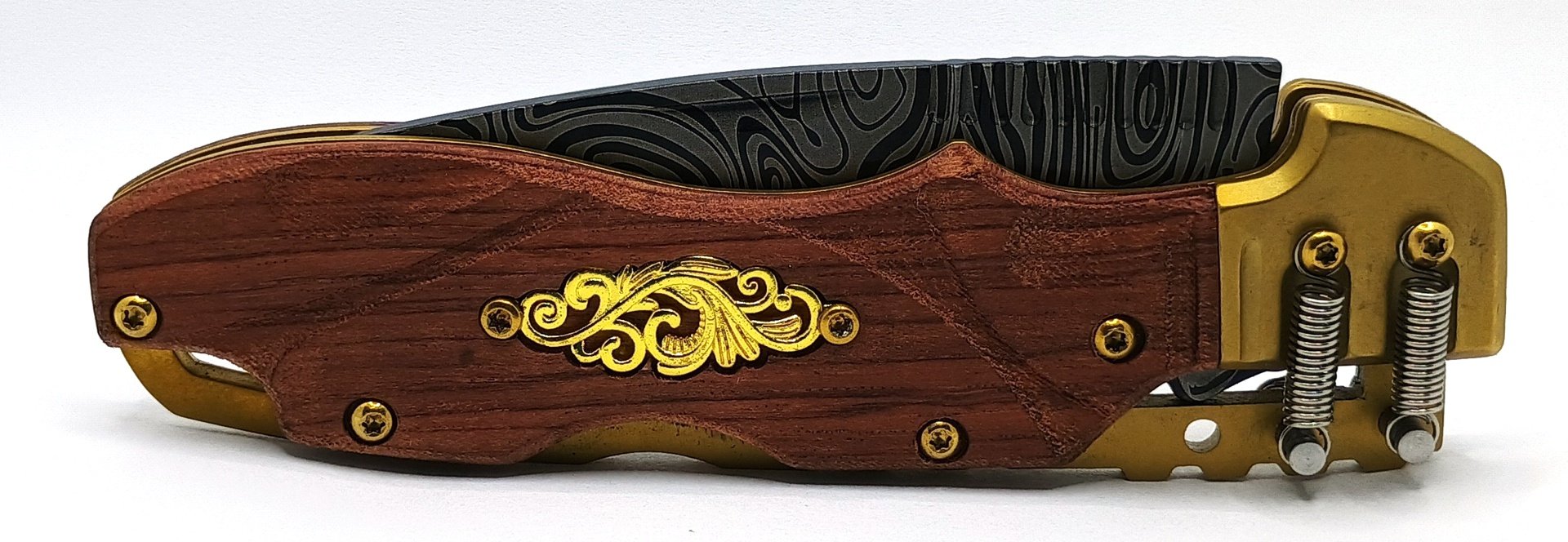
But never mind that. Strap on those goggles, tie up that scarf, and doff your top hat for this.
I’m going to have to have a bit of a stretch and a warm up before I can rattle off its name. One moment please…
…
Roight. This is the “NLX 8’’ Steampunk Design Lockback Pocket Folding Knife With Coated 420 Stainless Steel Blade. For Collection, Everyday Ccarry and Outdoor Activity Tool Knife (Damascus).” [sic]
It’s obviously a novelty knife. But that probably doesn’t matter much for the, shall we say, specific type of individual this is clearly meant to appeal to. You’re already not listening to anything I say, are you? Ah, I see you’ve already put one in your cart.
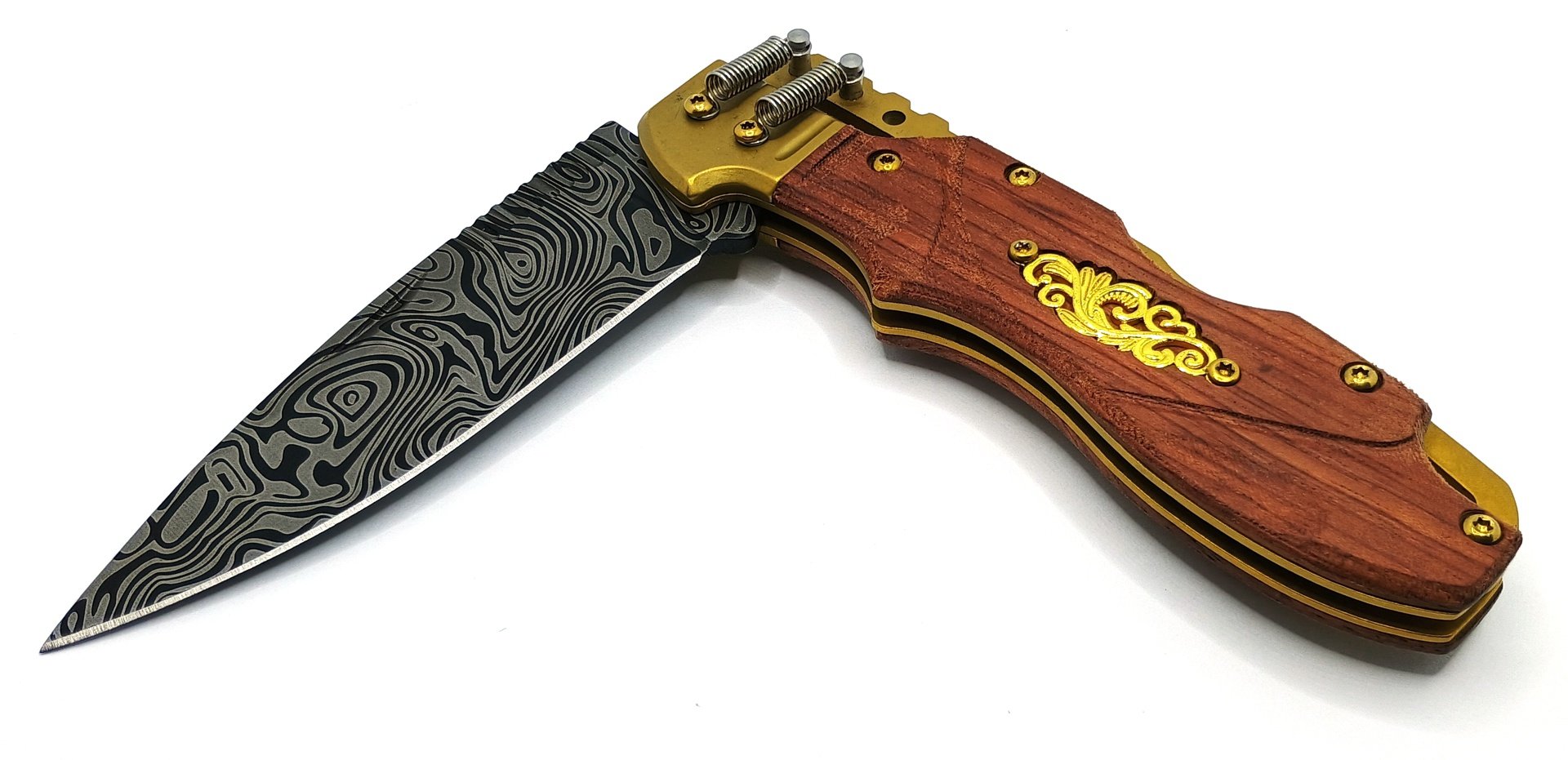
The NLX Steampunker is tailor made to just complete that look for anyone who’s already got a pair of brocade fingerless gloves, nine pocketwatches, and an impressive selection of waistcoats. It certainly has, to use the vernacular, an aesthetic.
Not an ᴀ ᴇ s ᴛ ʜ ᴇ ᴛ ɪ ᴄ, mind you. Although if anyone made a Vaporwave knife, unironically or no, I’d be the first to buy one.
No, this has an 𝖆𝖊𝖘𝖙𝖍𝖊𝖙𝖎𝖈, and it’s one that’s engraved on a brass plate in curly writing riveted to a mahogany door. An aesthetic that’s wearing a tailcoat and smoking a pipe. It’s a wonder it hasn’t got anywhere to shovel the coal.
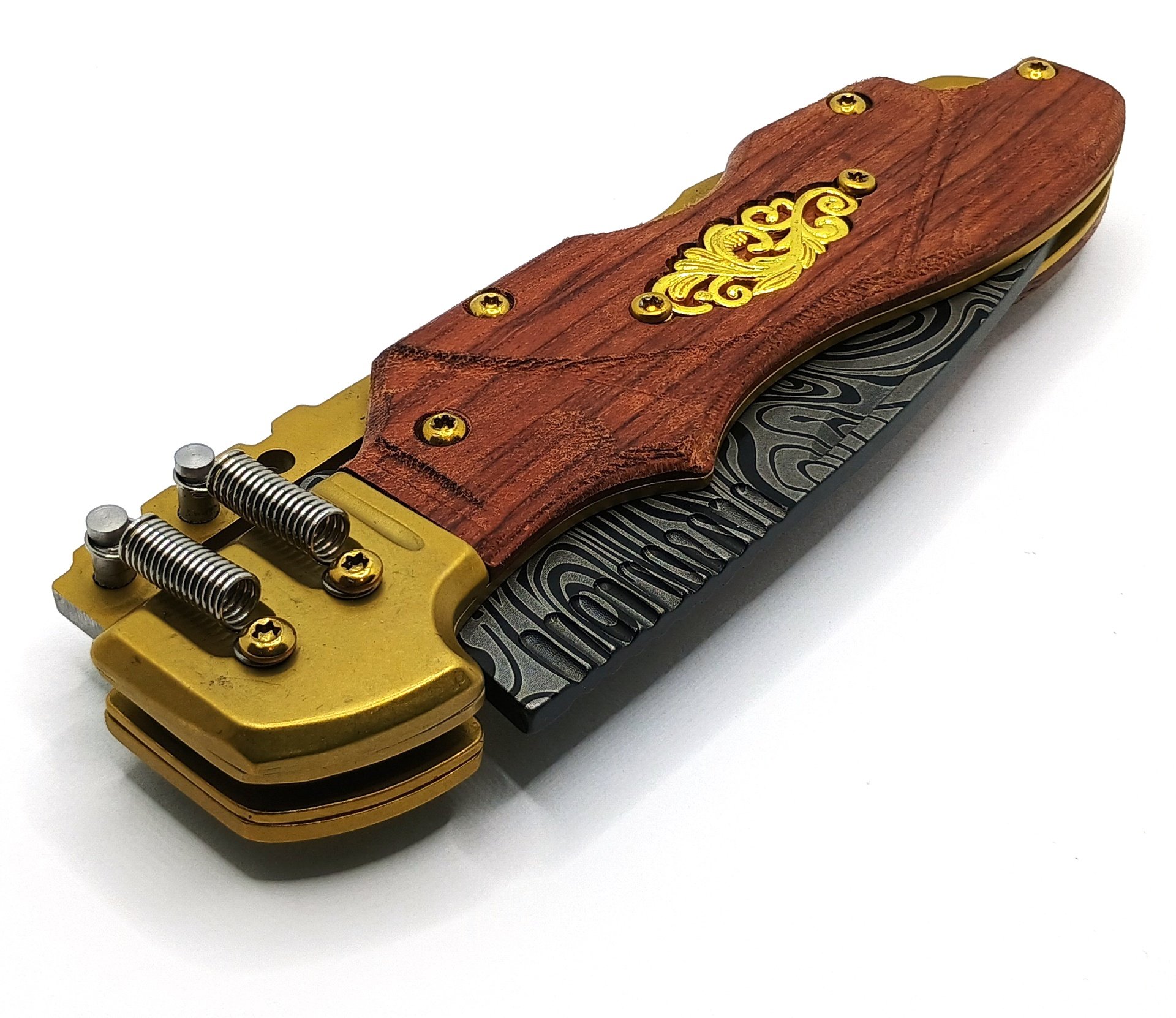
This is a lockback folding knife, and answers a question thus far unasked: “What if we put the lock springs on the outside?”
And so it does. Four highly visible extension springs are what power the lock bar.
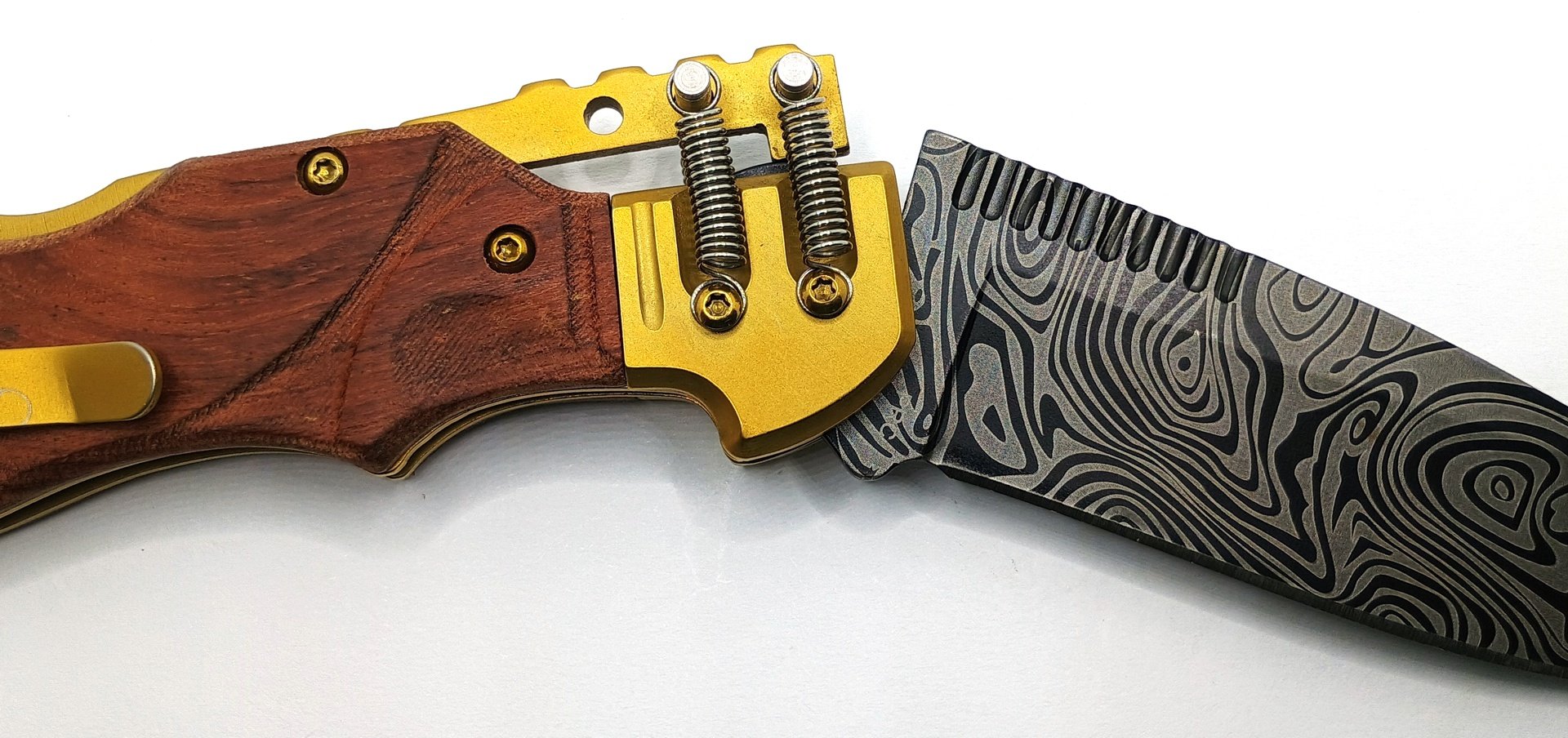
This has the side effect – no doubt intentional – of leaving the lockback mechanism itself proudly displayed while you operate it. Right there out in the open, ready to get either packed full of lint or pinch an incautious fingertip, all in the true 18th century tradition. So if you’ve ever become overcome by burning curiosity about how a lockback knife works, well, here it is showcased and ready for inspection.
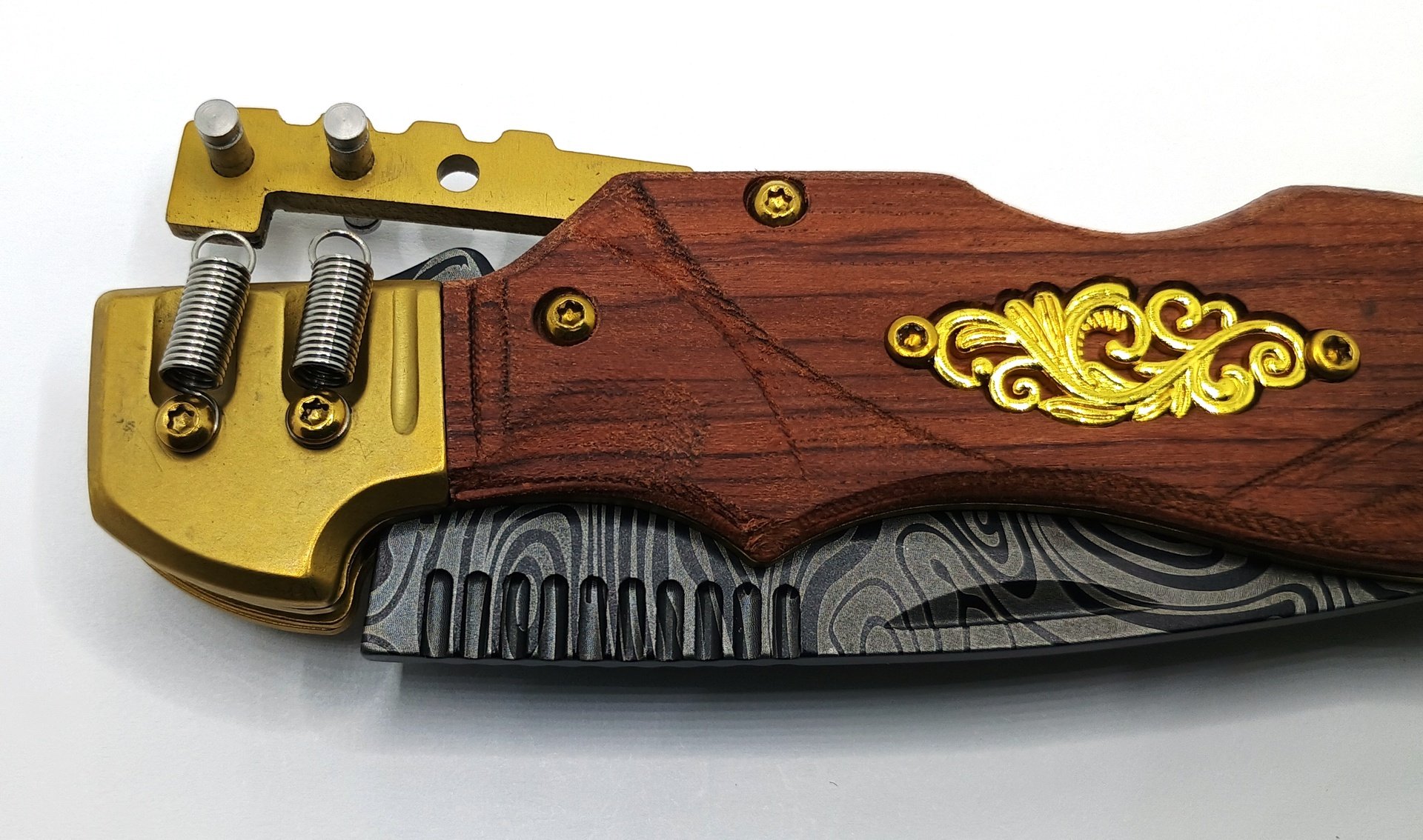
The springs are indeed fully functional and are not just visual frippery for the sheer joy of making the thing look like a Victorian light switch. They are truly what drives the action. They’re easy enough to unhook with a small pair of pliers or nimble fingers, and when disconnected the lock bar is unrestrained and is free to flop around of its own accord. To help prevent this from happening without your input, each spring’s eyelet rides in a small groove in its corresponding pin.
But if decorative frippery is what you want, the Steampunker has it in spades.
Clubs, hearts, and diamonds too, probably.
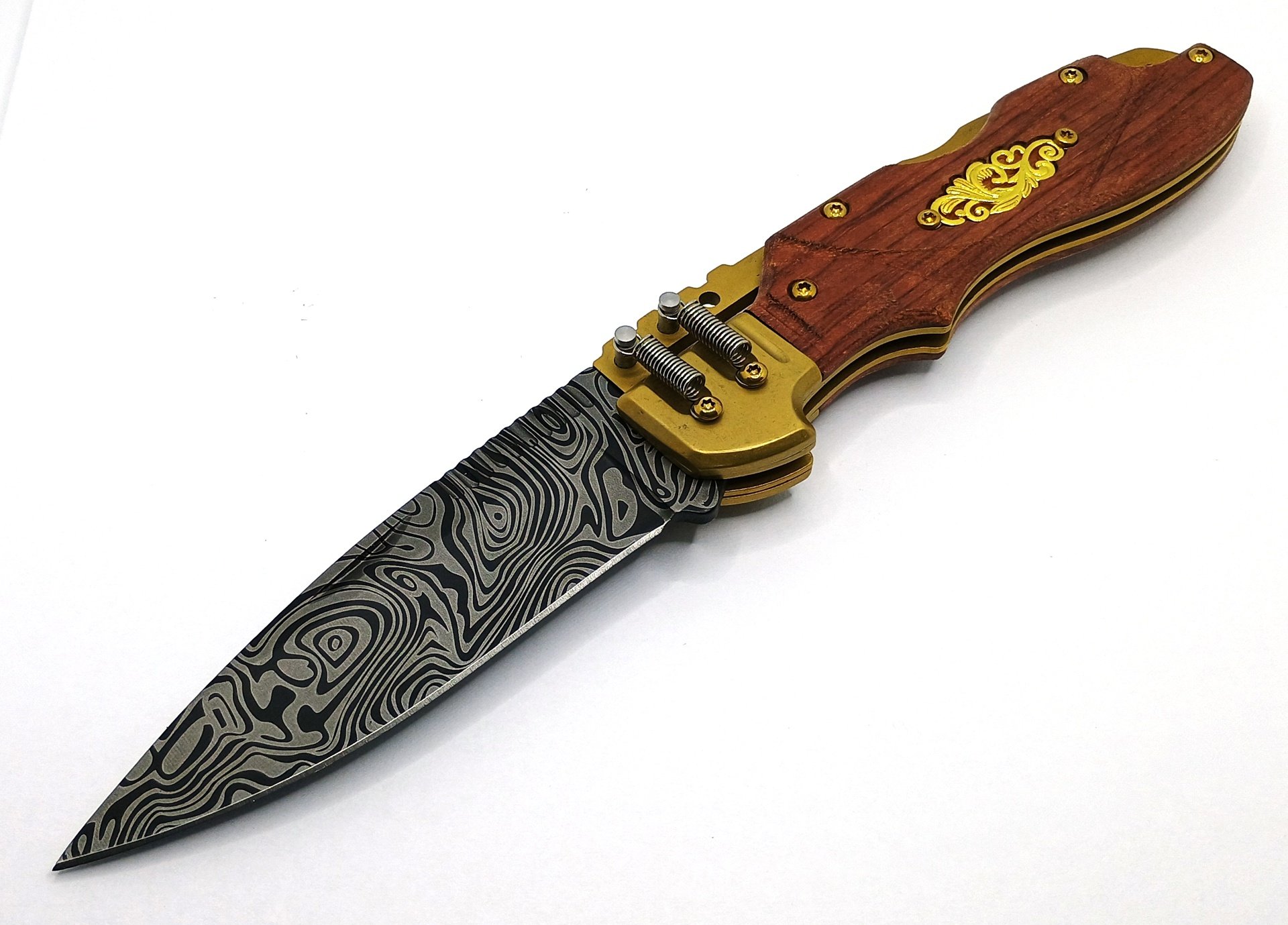
I am particularly fond of the shiny scrollwork medallion embellishing the middle of the handle. There’s only one of those on one side, because there is indeed a clip on the reverse:

The Steampunker is all wood and “brass,” and while there are a couple of variants of this knife mine is the “Damascus” version.
I’m having to use a lot of scare quotes here because a lot of things about the Steampunker are, that is to say, per se, in point of fact, actually fake.
None of the “brass” elements are actually brass, for instance. The bolsters, the clip, the liners, screws, and backspacer all have that brassy gold finish but a magnet sticks to them readily; they’re steel underneath. And the filigree embellishment is definitely a casting and its done surprisingly well, but it appears to be made of zinc that’s been electroplated with something.
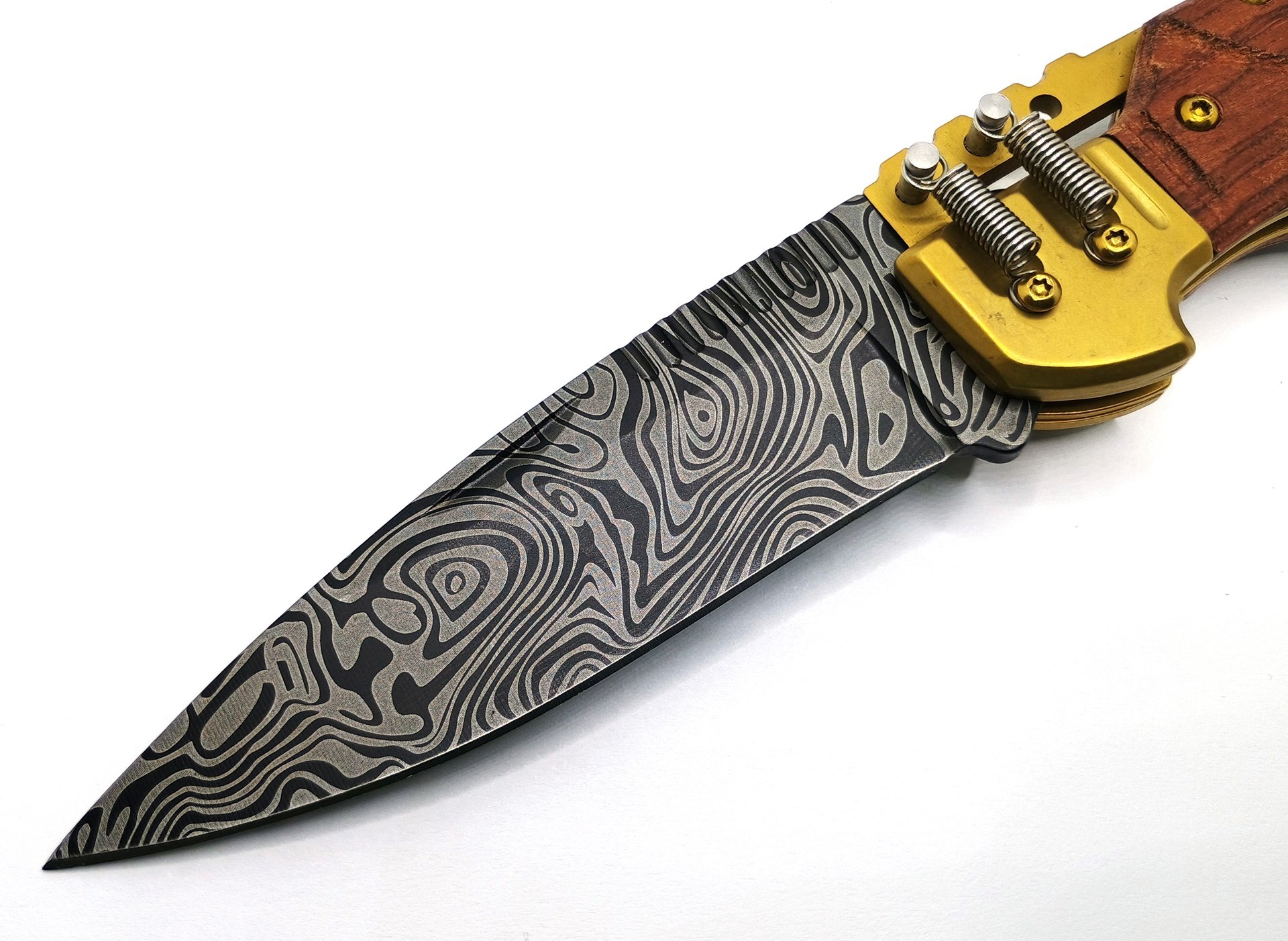
We can, if you like, dredge up the old argument about whether or not modern pattern welded “Damascus” steels actually technically deserve to be called Damascus steel or not. (You’re looking for the argument over whether or not a katana could cut a European sword in half? You’re in the wrong room. That’s three doors down the hall, to the left.)
But there’s no question that the Steampunker’s blade isn’t regardless, because it’s clearly just a painted-on pattern silkscreened over a plain steel blade. The dead giveaway is that the loops and whirls of the pattern fall into the fingernail nick and jimping notches and remain completely uninterrupted. Which they obviously wouldn’t do if the steel were truly layered and these details were machined in afterwards.
Another clue might be that the “Damascus” pattern is exactly the same on every single example of these, just printed right on from the same template on each and every one. If you grab any random product photo of one of these off the internet, compare it to mine and you’ll see the pattern is identical. The sole purpose of this sort of thing is precisely to look good in a catalog to anyone who doesn’t know any better, in order to part them with their money.
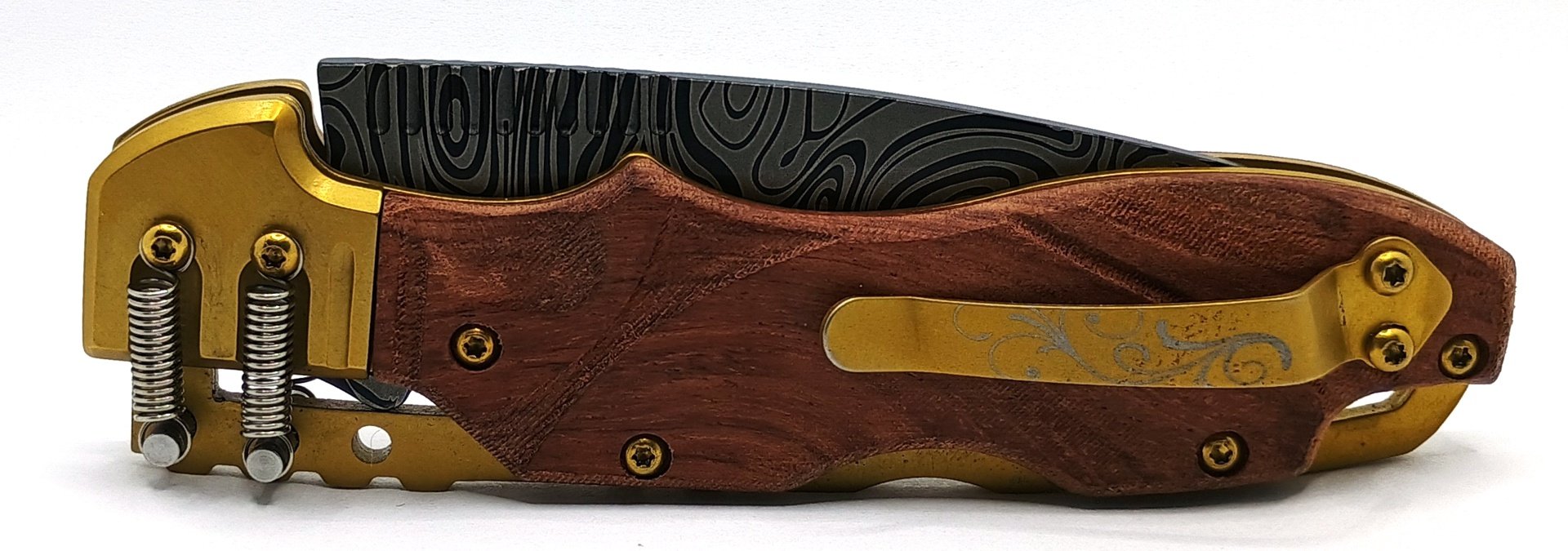
The wood, at least, is genuine. That’s not much of an impressive feature, though, because it is of exactly the same type of pedigree as the wooden scales on the souvenir pocketknife you’d find at a roadside gift shop right outside the National Park, the kind that’s pre-engraved with every name in the world except yours. It’s even stained in the same color, although to its credit it is nicely CNC routered with some grooves and scallops and a beveled finger notch on each side.
The clip is a traditional design and it is not repositionable. As above it is definitely steel and not brass, and it is mounted quite offset from the centerline. But its saving grace is that it’s offset to the correct side for a right handed user, i.e. nearer to the rear seam of the pocket, and it pains me to say this but it actually draws very nicely with a pleasant feel and the right balance of tension and release.
I have a few knives worth hundreds of dollars with clips that I like less. So stick that in your mill and grind it, why don’t you.
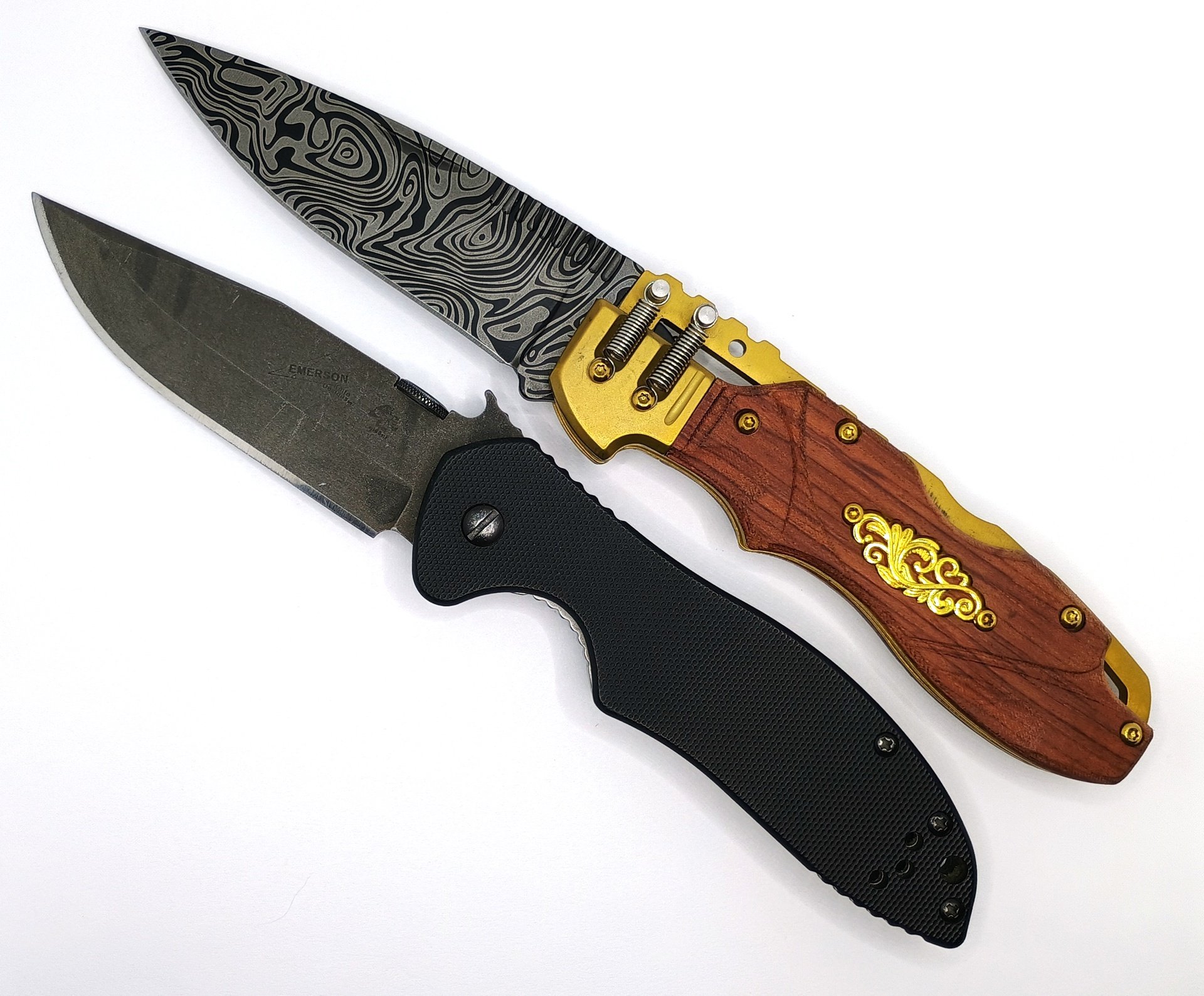
The Steampunker is definitely akin to a full sized knife. It’s every bit of 8" long with a 3-1/2" drop pointed blade that’s 0.110" thick and 1.041" across at its widest point which is at the root of the edge. There is a small almost-choil at the base of the edge followed by a ricasso that protrudes about 1/8". In total it weighs 128.7 grams or 4.54 ounces.
This is not, by any stretch of the imagination, a tactical knife. Towards that end there are no thumb studs, although there is a fingernail nick in the blade – only on the side opposite the clip. But the lock springs are weak enough and despite its gimcrack appearance the Steampunker’s action is smooth enough such that it actually is possible, with practice, to open it with one hand. Though only just.
The blade lockup is surprisingly solid both laterally and rotationally. Very little blade wiggle is present. In fact, the flexibility of the blade and very slight flexibility of the handles are the only notes I have to make. Despite these, there is no rattle within the actual mechanism.
The Steampunker’s thickness measurement is compounded not only by the clip, but also by the springs. Without them the handles themselves are 0.465" in thickness. With the springs it bulks up to 0.779", and including both the springs and the clip adds up to 0.859" which was a measurement that was damn difficult to take.
There’s very little else to say about the feature set. There is no spring assist or switchblade action; despite all the springs it’s just a regular old folder. The backspacer does include a loop that can be used as a lanyard attachment point. The spine on the lock bar is very broadly jimped, and for some reason there’s a superfluous hole in it, akin to the ones the spring mounting pins are pressed through but empty.

What with all springs and pins and greebles sticking out you’d expect the Steampunker to snag on every damn thing on the way out of your pocket but surprisingly, it doesn’t. If you are truly incautious it’s still possible to hook the springs on things inadvertently and if you’re truly hopelessly uncoordinated it’s not too difficult to knock of them off of their mounts in the process.
They’re captive on the other end, though, each held in place with the head of a screw so it’s not like they’ll get lost if you do. And they’re really not too tough to put back on, if it comes down to it. The lock will even still work with all but one of them disconnected, so you’d have to lose all four before anything dramatic happens.
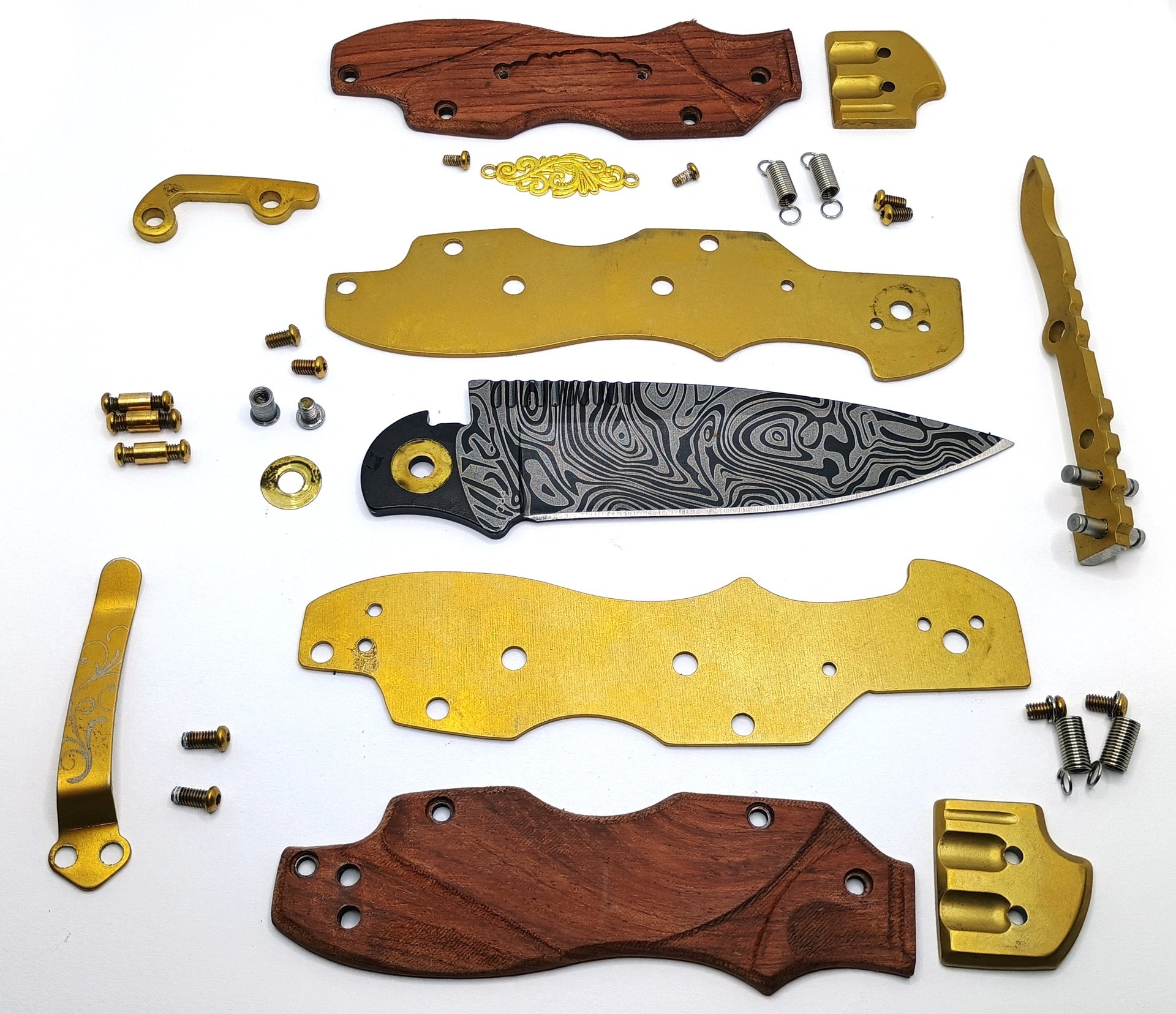
The Steampunker shatters into what feels like about a hundred pieces when you take it apart. It’s less complicated than it looks, although I do have one grievance to air out.
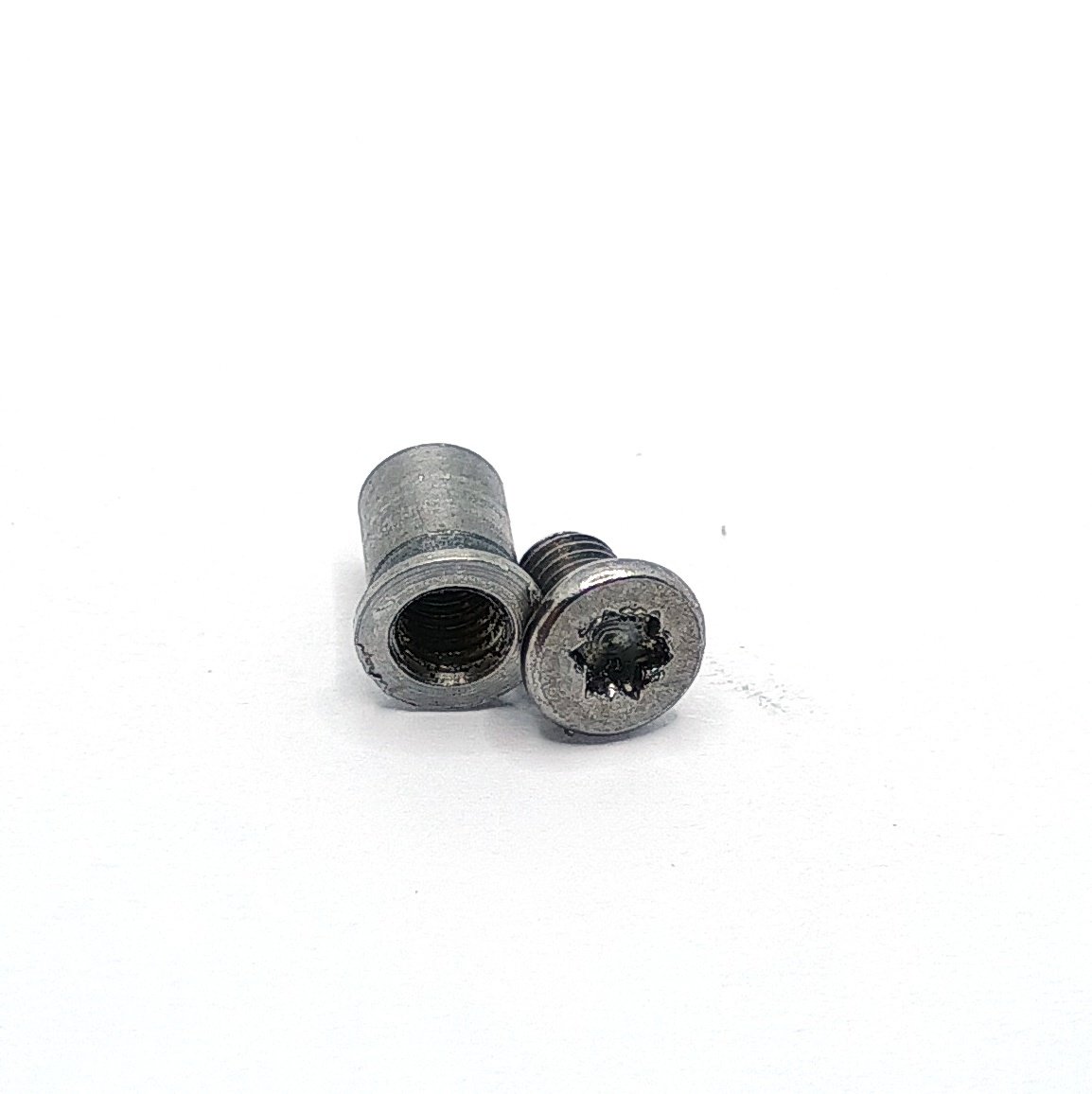
Here are both halves of the pivot screw. One is an ordinary Torx head (T8) but you’ll notice the other side doesn’t have a head at all; it’s just a threaded tube with a tiny little lip around the end.
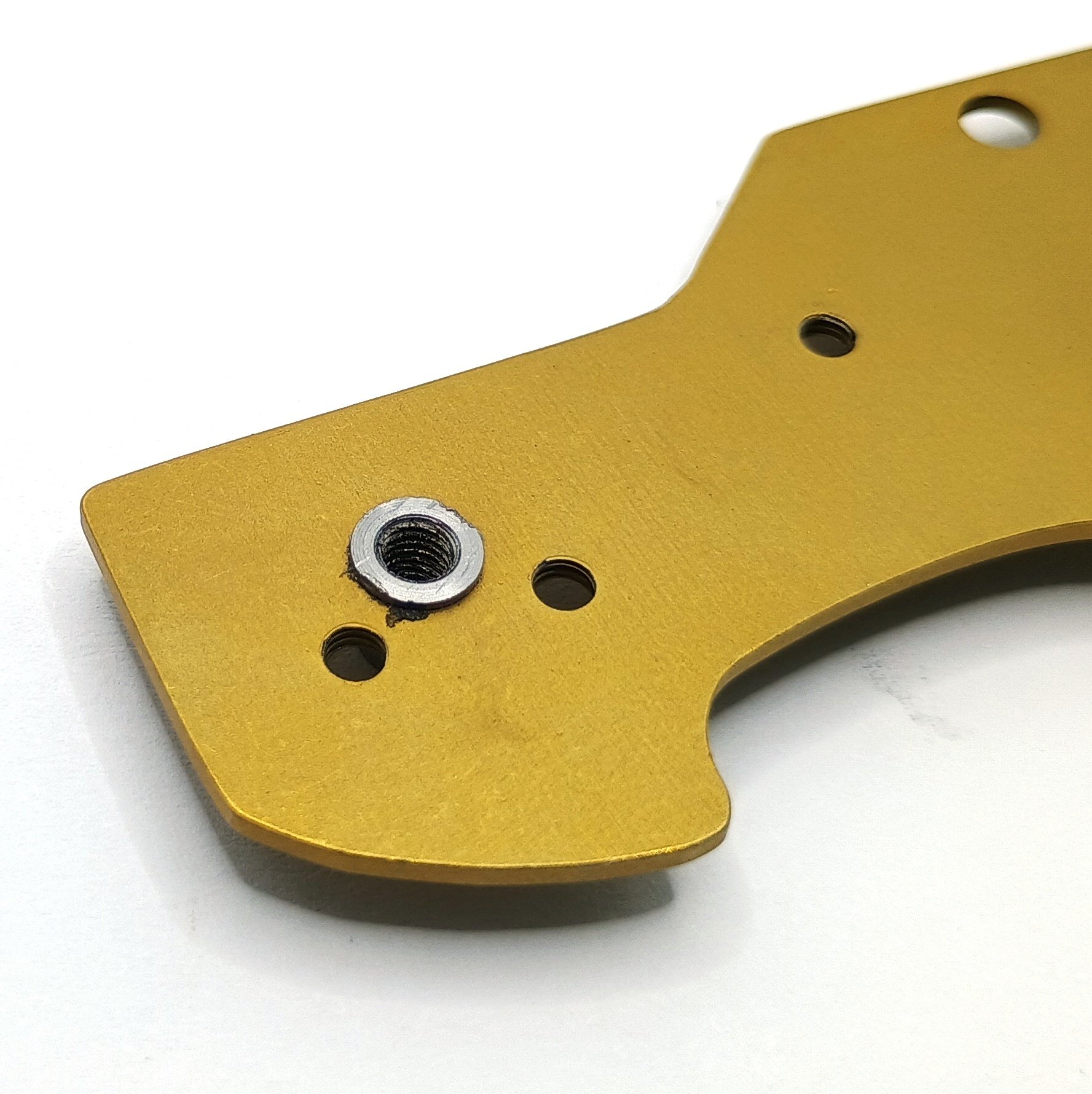
This sits nearly but not quite flush with the surface of the inner liner, and since there is no anti-rotation flat on it and every screw in this thing was threadlockered to hell and back, attempting to undo the pivot screw just causes the entire assemblage to spin in the hole. So getting the little blighter apart was a puzzle box I was not expecting to have to open today. You can see the aftermath of my grabbing it with pliers in the photo above. A soldering iron was also involved. I don’t think it would have been too much of an ask for the manufacturer, whoever they are, to put a hex head or some wrench flats on it or something.
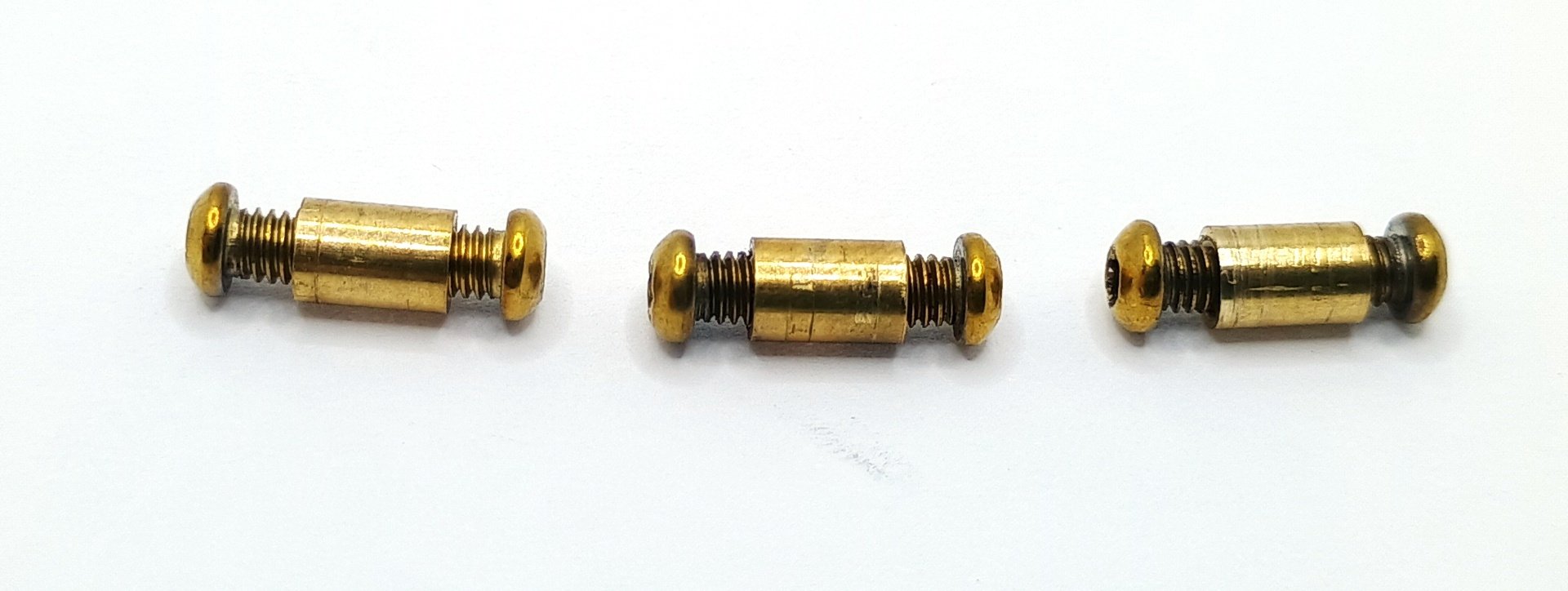
The Steampunker is largely held together with these three threaded barrels, which accept a screw on either side and once again do not have any anti-rotation features or engage with the liners in any mechanical sense. One of them is the pivot point for the lock bar and the other two go through the backspacer in the tail. All of them will merrily spin forever without fully releasing their screws unless you clamp them with something.
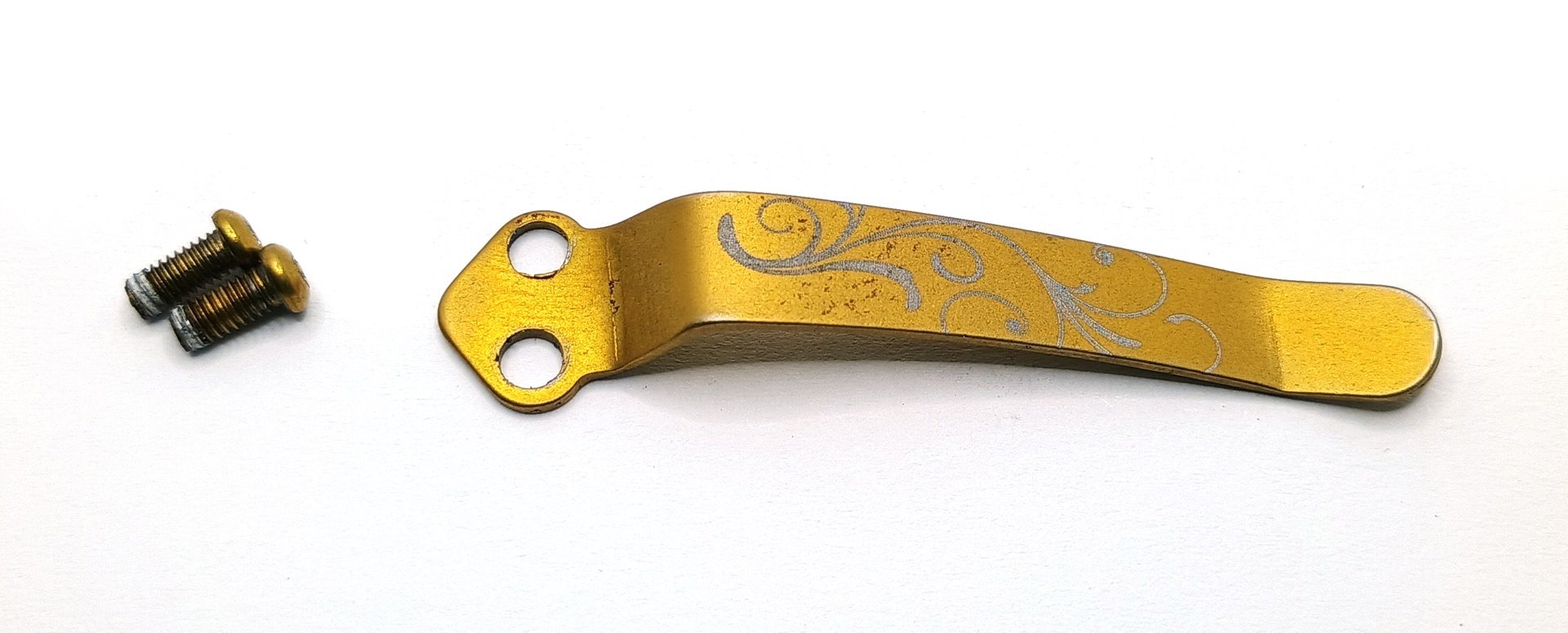
The clip has this little bit of scrollwork decoration on it, and on my example is already showing some rust spots. A visible indentation was left in the metal where it met the bending brake at the factory as well. It’s easily the crudest part of the entire ensemble. I haven’t decided yet if I’m motivated enough to pickle and re-electroplate it.
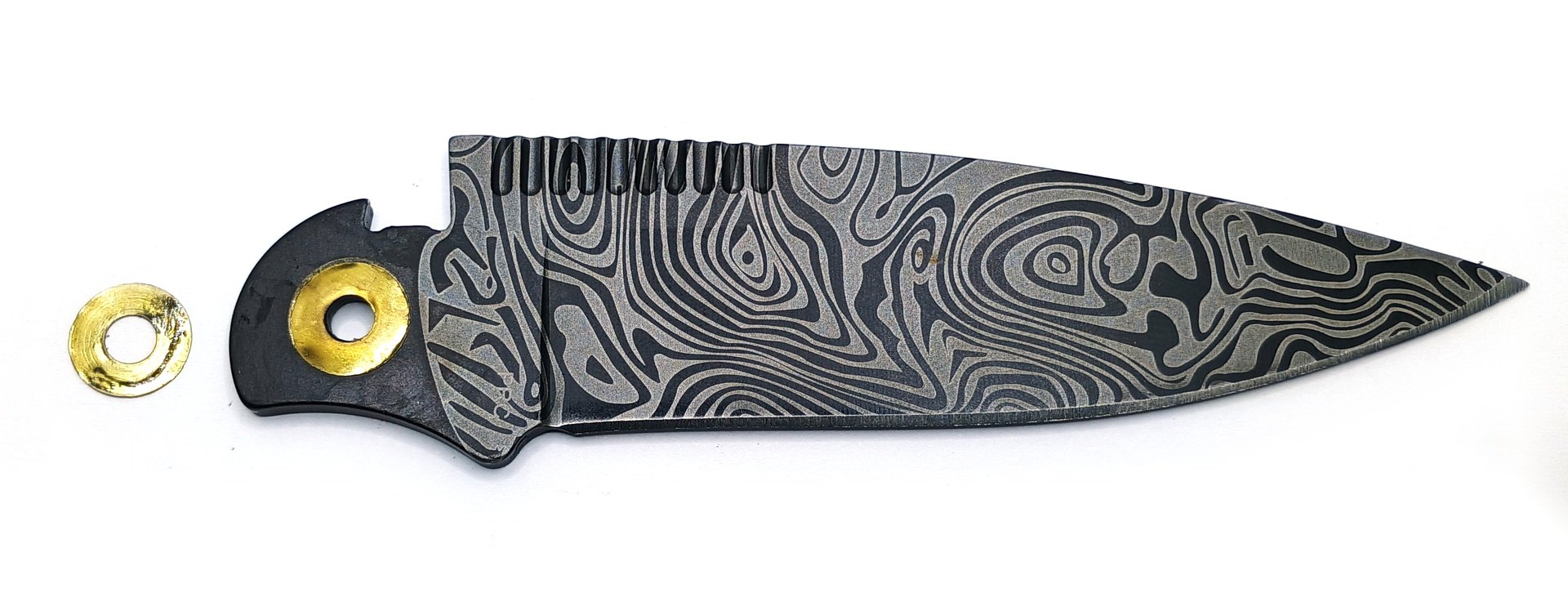
Earlier I said all the “brass” components on this knife weren’t really brass. That’s not actually true, as it happens, because the pivot washers actually genuinely are. Go figure. They’re not ultra-refined or anything, but they get the job done and brass is a fair sight better than plastic. Or no washers at all, come to think of it.
Note also the “PRC” marking on the heel of the blade, which is the only inscription on the entire knife. Needless to say it is unequivocally made in China.
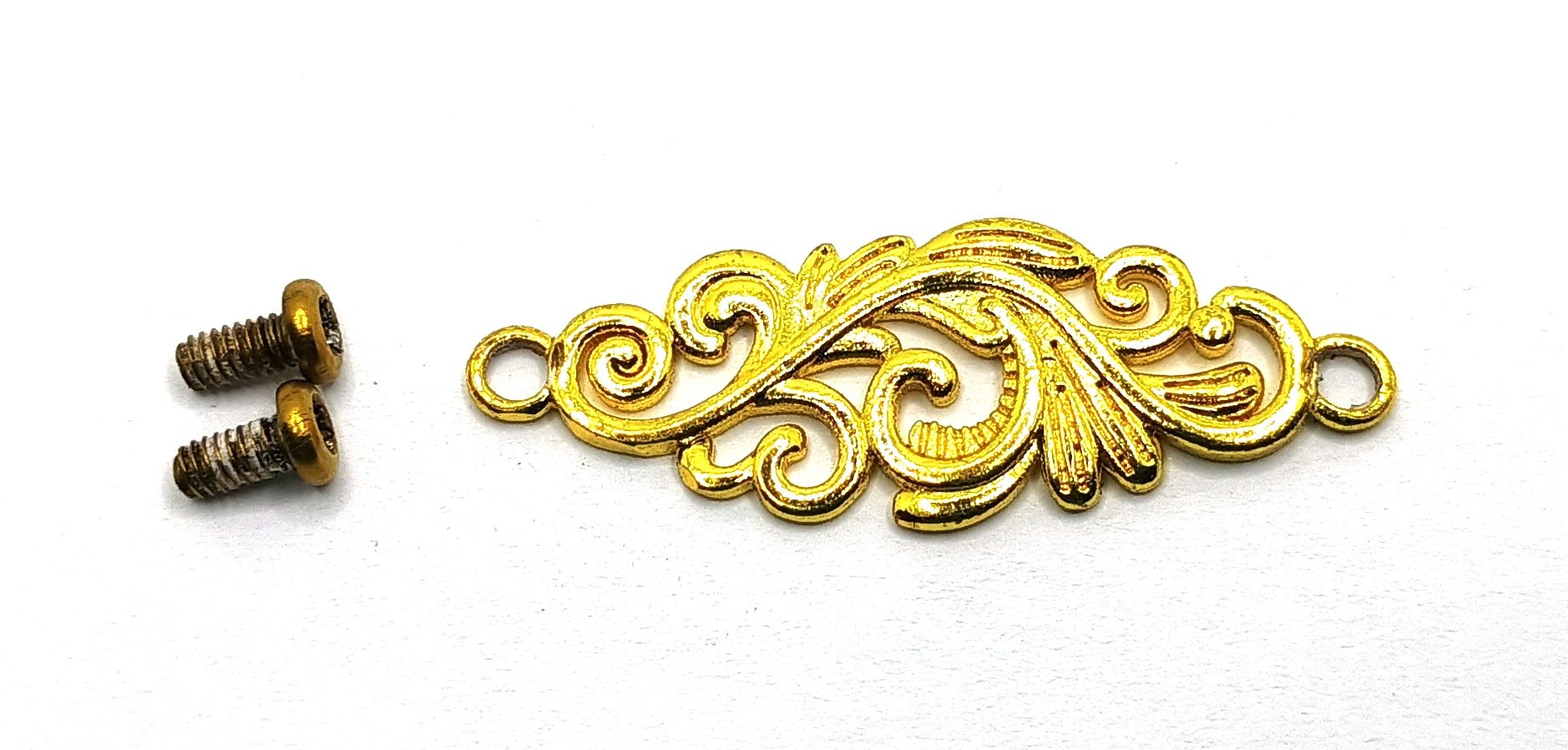
Here is the medallion from the handle. It’s easily my favorite detail on the whole knife, which is why I keep harping on about it. The casting work is excellent and contrives somehow not to appear to be cheap, even though it unquestionably is. I don’t doubt for a second that you could find this same part as a generic decorative finding somewhere, probably in purchase lots of a thousand units. The one curious thing about it is that it’s mounted with the same M3 machine screws as used elsewhere in the knife, but they don’t touch the steel liners and are just reamed straight into the wood.
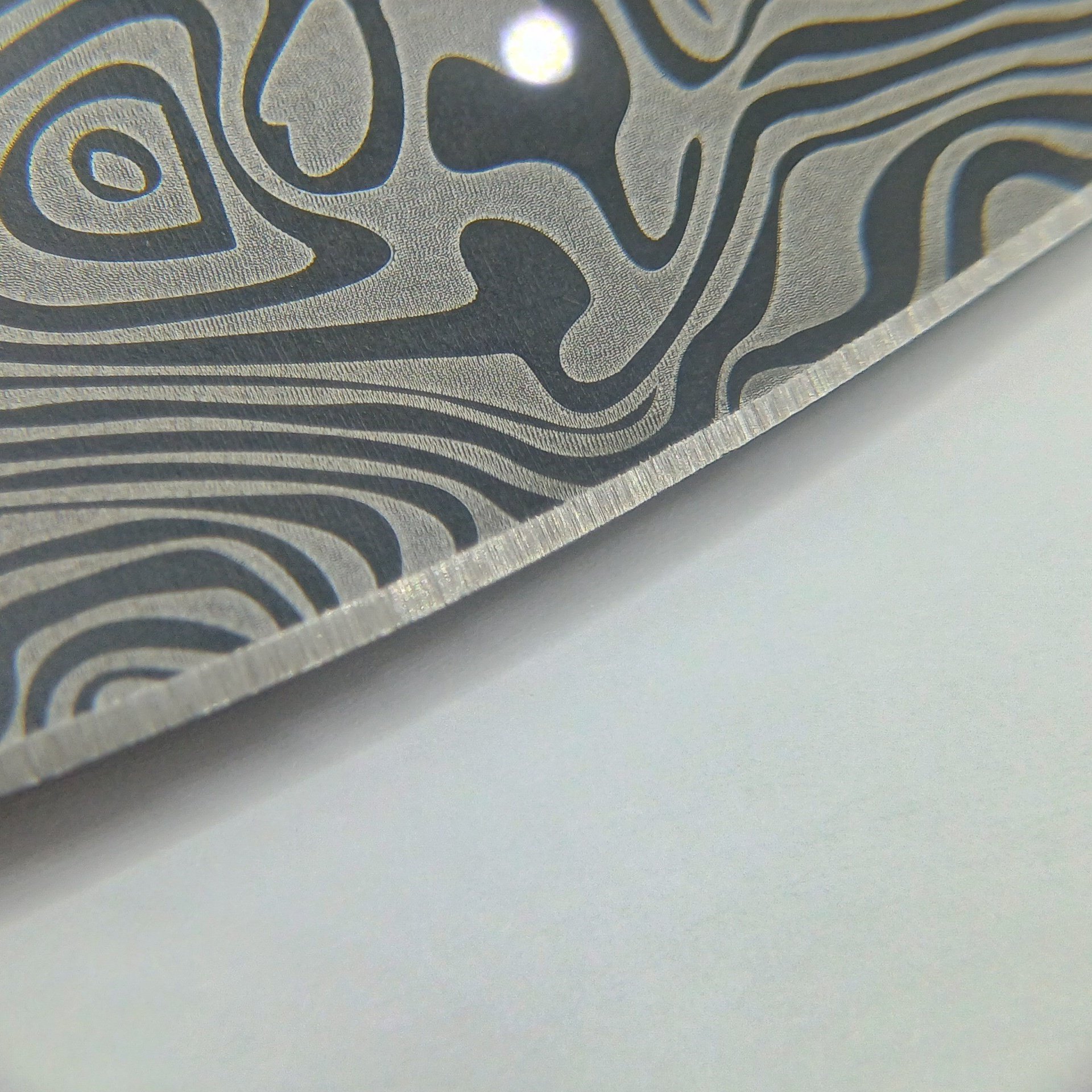
It is deeply silly, with a $19 novelty piece like this, to enter into it with any kind of expectations whatsoever about the edge. My example arrived noticeably dull, with the crude edge grind illustrated here. Dull I can deal with, but those notches and chips in it are as it was delivered from the factory. I haven’t used this knife to cut anything, and to be fair it’s doubtful that I ever will.
The product description claims the blade is made out of “420” steel but does not specify which variant. It’s possible, I suppose, to maintain some kind of whimsical faith that it might be as nice as 420J2, for instance. But I wouldn’t hold your breath on that, because all you’re liable to do is turn your face blue.
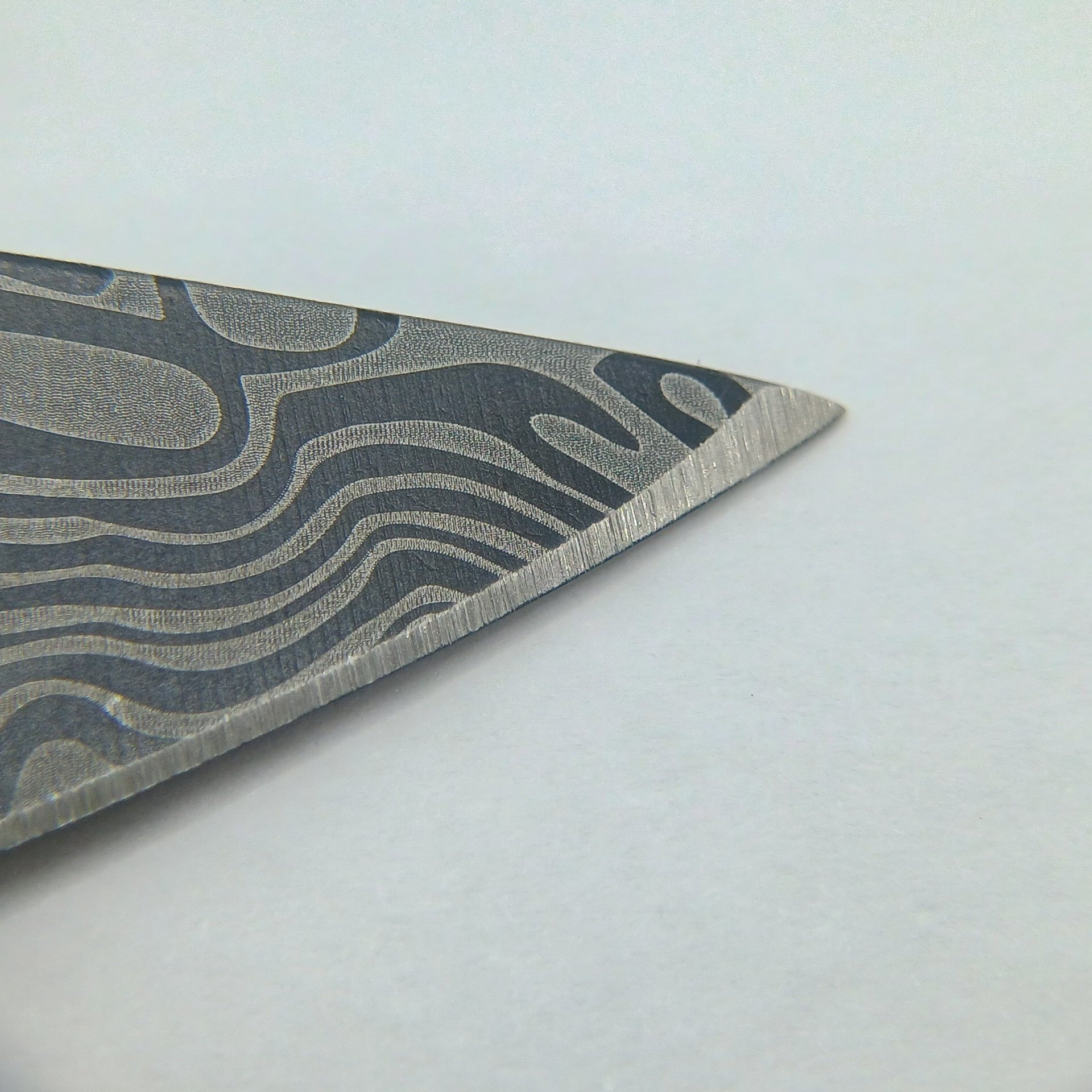
I would conjecture that the edge was ground by hand, given how it noticeably changes towards the tip.
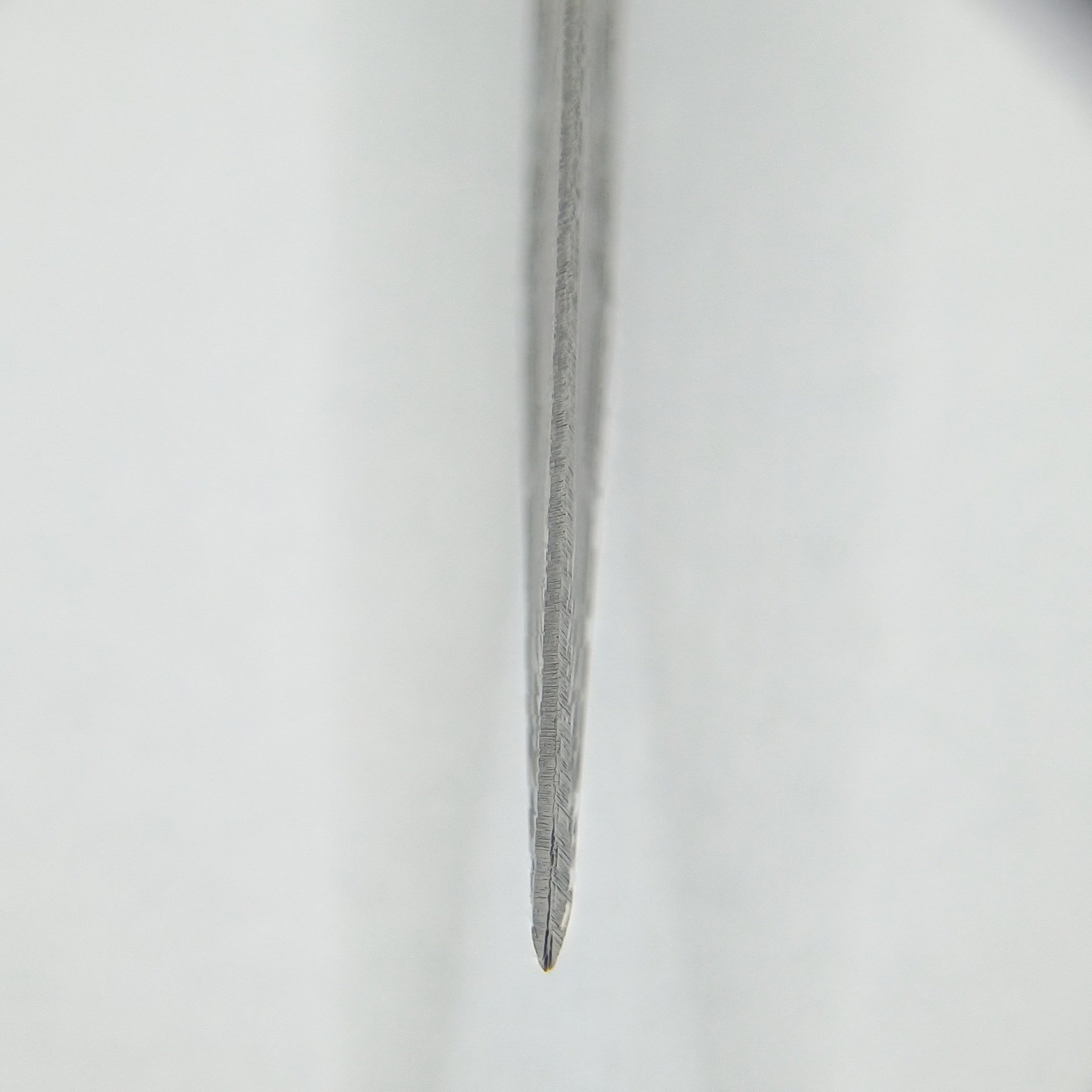
Here’s the essential truth of the matter, as it were.
As you can see, the edge angles are quite noticeably different from one side of the blade to the other. At this point I should quote some aphorism about price, but you’ve surely heard them all before.
The Inevitable Conclusion
I deeply respect the dedication that’s caused you to read Neal Stephenson’s The Diamond Age cover-to-cover seventeen times, I really do. But they still won’t let you into the convention with any real edged weaponry about your person.
The NLX Steampunk knife may be silly, and it may be kind of impractical, but damned if it doesn’t look cool. And that’s what it’s really all about, here. All the urchins and society ladies will see you strutting down the street and they’ll say, “That chap right there, he is one anachronistic muthafucka.”
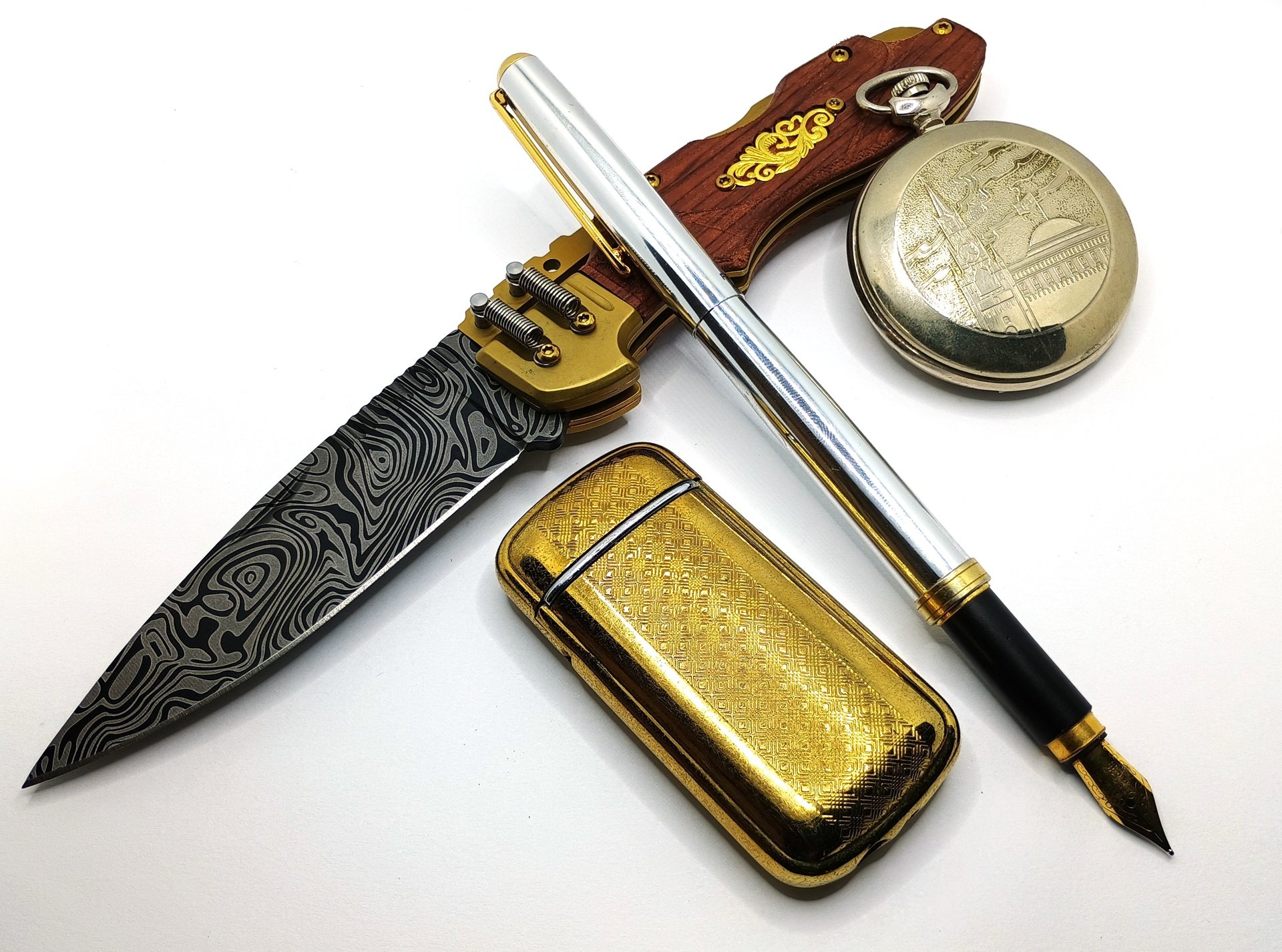
You already know if you want one. You already know if you don’t.


That was a magnificent review! I wouldn’t touch that thing with kevlar gloves, but I have already had more fun with it than the price suggests would be possible.